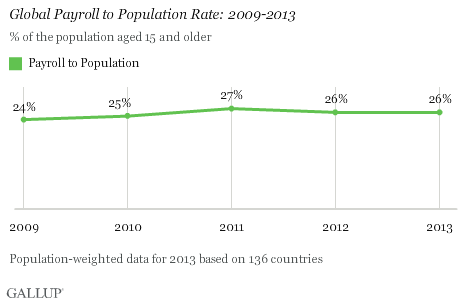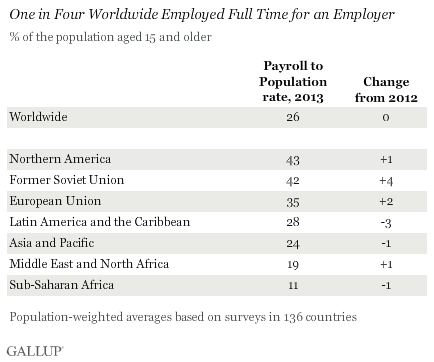This article is part of a weeklong series focusing on how people worldwide answer some of today's most pressing questions about employment and the economy.
WASHINGTON, D.C. -- About one in four adults worldwide -- or roughly 1.3 billion people -- worked full time for an employer in 2013. Gallup's Payroll to Population (P2P) rate, which reports the percentage of the total adult population that works at least 30 hours per week for an employer, has not grown since 2012.

Gallup's latest global P2P measurements are based on more than 136,000 interviews across 136 countries in 2013, in which adults were asked a battery of employment questions modeled on the International Labour Organization's standards. Gallup does not count adults who are self-employed, working part time, unemployed, or out of the workforce as payroll-employed in the P2P metric, and it is not seasonally adjusted.
The countries with the highest P2P rates tend to be some of the wealthiest -- or those with the highest GDP per capita -- such as the United Arab Emirates and the U.S. Additionally, a number of countries on the list, such as Sweden, Bahrain, and Russia, rank toward the top because each has many people working directly for the government or government-owned entities.

Countries with the lowest P2P scores tend to have large informal economies with high self-employment, which at the global level has a negative relationship with GDP per capita. In Nepal, for example, which has a 9% P2P rate and $690 per capita GDP, 38% of the adult population reports being "self-employed." Similarly, Burkina Faso has a 5% P2P rate and $652 per capita GDP, and 28% of adults there are "self-employed." This pattern is replicated in many sub-Saharan African countries, helping make the region's 11% P2P rate the lowest of any region in the world. This rate is down slightly from 12% in 2012.
Regionally, Northern America (43%) and countries in the former Soviet Union (42%) had the highest P2P rates in 2013. At the other end of the spectrum, along with sub-Saharan Africa, the Middle East and North Africa continues to perform poorly with respect to P2P -- with the 19% P2P rate at least partly attributable to the 52% of the population not participating in the workforce.

The Northern America region consists of Canada and the U.S, which -- like other highly developed economies -- have relatively high workforce participation (70% in Canada, 69% in the U.S.), comparably low unemployment, and high rates of formal economic employment well integrated into the global economy. P2P rates in the U.S. and Canada were generally flat at 43% and 42%, respectively, in 2013.
The 42% P2P rate for the former Soviet Union region in 2013 not only rivaled that of Northern America, it showed the biggest increase worldwide. This was primarily attributable to the increase in Russia's P2P rate (from 44% to 51%) and its population size relative to the region. Russia and Belarus are the only countries in the region with P2P rates higher than 40%, attributable to their high workforce participation and low under- or unemployment. At the other end of the scale, residents of Armenia, Kyrgyzstan, and Tajikistan all report P2P rates lower than 20% and workforce participation rates of 55% or less.
In the Middle East and North Africa, a combination of low workforce participation and high unemployment continues to drive the low P2P rate. While some small Middle East countries such as Bahrain or the UAE have P2P rates higher than 50%, the much larger countries of Egypt, Iraq, Morocco, and Yemen (at only 12%) have lower P2P, bringing the region's total score down to 19%. Low workforce participation among women is a large factor in the region; three-quarters or more of women in Egypt, Morocco, and Yemen are out of the workforce, compared with 37% in the U.S.
Implications
According to the ILO, 200 million people worldwide were unemployed in 2013. This number grossly misrepresents the global jobs situation. The traditional way unemployment is calculated does not take into account people who are out of the workforce or self-employed out of necessity, and/or those who may work within the informal economy. This is why developing countries such as Pakistan, China, and Thailand report such low unemployment rates of 6.0%, 4.1%, and 1.2%, respectively. Contrast that with developed countries such as the U.S. and France, which respectively report slightly higher unemployment rates of 6.2% and 10.1%. When viewed at the country level, unemployment does not statistically correlate to GDP per capita.
The Gallup World Poll has found repeatedly that what the whole world has in common is that everyone wants a good job. In 2013, about one in four worldwide fit into this category. If this is the new will of the world, better metrics are required on the global jobs situation -- metrics that allow for direct country comparisons and correlate to GDP per capita. Payroll to Population is a start.
The data in this article were generated from Gallup Analytics. For complete data sets or custom research from the more than 150 countries Gallup continually surveys, please contact us.
Survey Methods
Results are based on telephone and face-to-face interviews with approximately 1,000 adults in each country, aged 15 and older, conducted in 2012 and 2013. For results based on the total sample of national adults, the margin of sampling error ranged from ±2.1 percentage points to ±5.6 percentage points at the 95% confidence level. The margin of error reflects the influence of data weighting. In addition to sampling error, question wording and practical difficulties in conducting surveys can introduce error or bias into the findings of public opinion polls.
For more complete methodology and specific survey dates, please review Gallup's Country Data Set details.
